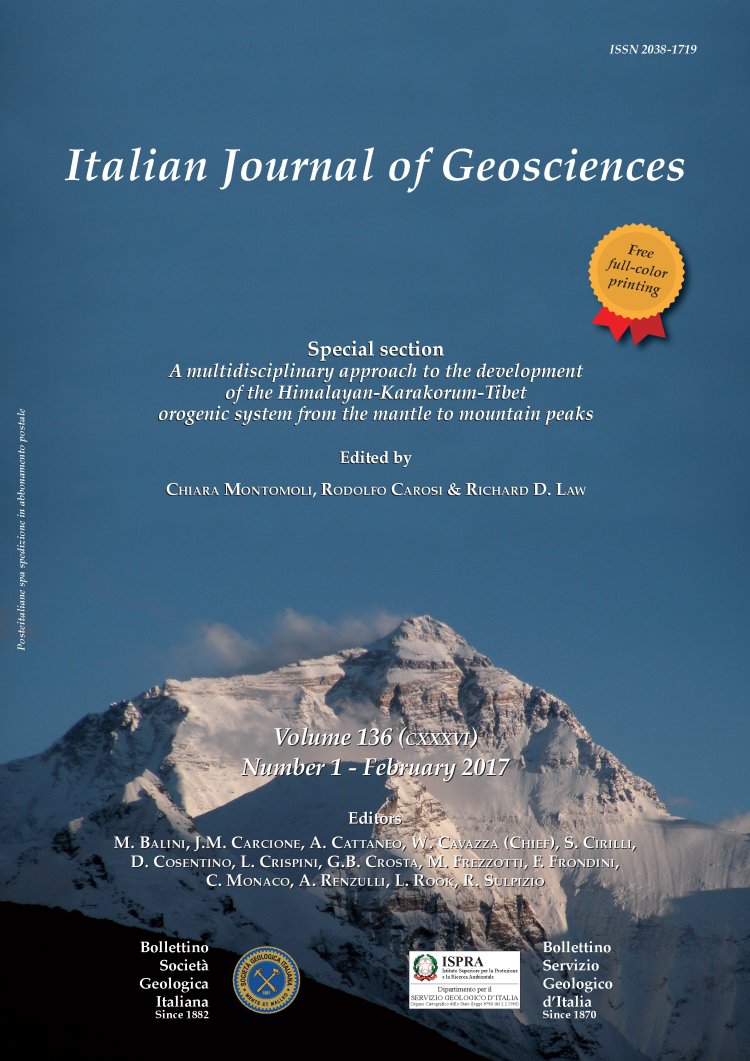
Continental subduction in the NW-Himalaya and Trans-Himalaya
Arvind Kumar Jain (*)
(*) CSIR-Central Building Research Institute. Corresponding author e-mail: himalfes@gmail.com.
Volume: 136 (2017) f.1
Pages: 89-102
Abstract
As the vast Neo-Tethyan Ocean, separating the Indian and Asian Plates, the closed along the Shyok and Indus-Tsangpo Suture Zones (SSZ and ITSZ) during late Mesozoic, these plates did not initially collide with each other. Instead, the Tethyan oceanic lithosphere subducted and partially melted to produce an intra-oceanic calc-alkaline Shyok–Dras Volcanic Arc, followed by its subduction and melting beneath the Asian Plate to produce the Karakoram Batholith. The Ladakh Batholith subsequently intruded the volcanic arc.
The Indian continental lithosphere first approached the trench of the ITSZ and subducted steeply to undergo ultra-high pressure (UHP) metamorphism at ~53 Ma. Comparison of bulk ages from the Ladakh Batholith with the subducted UHP metamorphosed Indian continental lithosphere in Tso Morari across the ITSZ provided constraints on the India-Asia convergence at ~58 Ma. The Himalaya first emerged from this deeply exhumed terrane between 53 and 50 Ma. Repeated sequential subduction and imbrication of the Indian continental lithosphere followed at ~45-35 and ~25-15 Ma to produce Eo- and Neo-Himalayan metamorphism and associated exhumation episodes during rise of the Himalayan Mountains from north to the south.
Geological and geophysical evidences from the Himalaya and nearby mountains bespeak about steep subduction and imbrication of the Indian continental lithosphere since ~58 Ma. Present-day subhorizontal subduction of the Indian Plate and its episodic northward push along the Main Himalayan Thrust (MHT) has rotated these imbricates so that these follow the present-day geometry of the Indian continental lithosphere. Overriding scrapped imbricated sequences thrust southwards and deform into the Himalayan crustal wedge. The Bangong-Nujiang Suture (BNS) in Central Tibet witnesses true "collisional" signatures of large-scale opposing vergence of the India-Asia Plates.
The Indian continental lithosphere first approached the trench of the ITSZ and subducted steeply to undergo ultra-high pressure (UHP) metamorphism at ~53 Ma. Comparison of bulk ages from the Ladakh Batholith with the subducted UHP metamorphosed Indian continental lithosphere in Tso Morari across the ITSZ provided constraints on the India-Asia convergence at ~58 Ma. The Himalaya first emerged from this deeply exhumed terrane between 53 and 50 Ma. Repeated sequential subduction and imbrication of the Indian continental lithosphere followed at ~45-35 and ~25-15 Ma to produce Eo- and Neo-Himalayan metamorphism and associated exhumation episodes during rise of the Himalayan Mountains from north to the south.
Geological and geophysical evidences from the Himalaya and nearby mountains bespeak about steep subduction and imbrication of the Indian continental lithosphere since ~58 Ma. Present-day subhorizontal subduction of the Indian Plate and its episodic northward push along the Main Himalayan Thrust (MHT) has rotated these imbricates so that these follow the present-day geometry of the Indian continental lithosphere. Overriding scrapped imbricated sequences thrust southwards and deform into the Himalayan crustal wedge. The Bangong-Nujiang Suture (BNS) in Central Tibet witnesses true "collisional" signatures of large-scale opposing vergence of the India-Asia Plates.
Keywords
Get Full Text